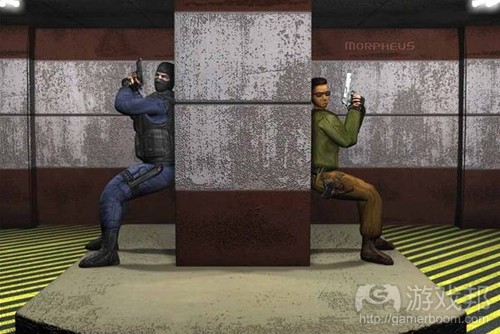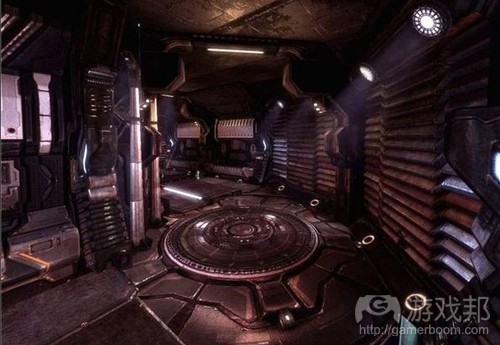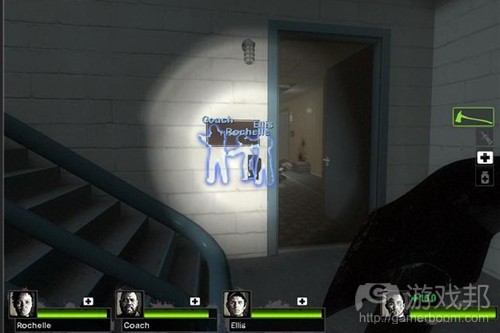分享FPS多人游戏关卡和地图设计技巧
作者:Simon Hill
处于成长期的游戏设计师往往会惊奇地发现,游戏设计不仅仅是构思想法。游戏的基本构想仅仅是开发项目的种子,设计还包括细节化的游戏机制及其他游戏运转所需的各种内容。玩顶级游戏,考虑开发者在游戏内容的关键层面所做的决定,能够学到大量有关游戏设计理论的知识。目前,该主题的相关书籍也很多,甚至还有游戏设计课程。但是,学习和提升游戏设计知识的最佳方法是钻研和制作游戏。
我们将在本文探讨第一人称射击题材游戏中的多人地图设计。FPS游戏有着极为庞大和卓越的mod制作社区。而且,只有同其他玩家一起玩游戏才能够体验到游戏的深度和真正的乐趣。所有支持庞大在线社区的顶级FPS系列游戏都遵循着一套制作FPS多人游戏地图的规则。在此我们将陈述和讨论部分多人游戏地图规则,通过些许范例来说明。
复活点
所有多人地图都需要复活点,但是玩家重新生成的方法有许多种。早期多人地图存在频繁生成杀戮的问题,玩家找到其他人的复活点后埋伏在附近,在对手生成但还无法移动时杀死他。还未离开起始点就被人杀死,这无疑是最令人懊恼的事情。
在《反恐精英》之类的组队游戏中,玩家往往会在地图两端的安全区域内生成。这种方法对《反恐精英》极为有效,因为玩家在游戏中无法重生,死亡便意味着个人在这个回合的游戏已经结束。《使命召唤》系列游戏包含重生系统,玩家会重生自己同队队员附近且远离敌人,这也是种较好的做法。
地图设计师必须制定潜在复活点的位置,而且这些位置应当处在玩家能够得到掩护的区域。他们还需要让玩家在复活时面对其他区域而不是墙壁。
虽然《反恐精英》系统也能够用于玩家死亡后重生的多人游戏,但是如果游戏地图过大,那么玩家便要走很长时间才能重新投入战斗。设计师可以采用的最佳系统是设置多个生成点,游戏代码会查看对手玩家的位置,只在远离他们的位置重生。在团队游戏中,你需要在尽可能靠近队友的位置生成玩家,但是不要让他们在交战区域复活。
阻塞点
所有的优秀多人游戏地图都有许多阻塞点或冲突点。这些是最容易爆发战斗的瓶颈区域。在《反恐精英》之类的团队游戏中,两个队伍的复活点与目标和阻塞点的距离相同,这对多人游戏地图来说至关重要。在我玩的每场《反恐精英》战斗中,两个队伍一开始都会冲向阻塞点并抛掷闪光弹,然后再进入战斗区域。
在FPS多人游戏地图和开发区域提供多条路径确实是很不错的想法,尤其是提供纵向层面的移动和路径,这总是会让游戏变得更加有趣,但是阻塞点才是呈现游戏玩法和确保产生大量危险遭遇战的关键。
布局
“8”式是可用于多人游戏地图中的最简单布局。这个布局由两个循环和中间的主阻塞点组成。《虚幻竞技场2003》中就有个这样的地图,称为“Training Day”。这样的地图节奏相当快且场面极为混乱。这样的地图确实与游戏玩法相符,但是缺乏喘息的空间,很快就会让玩家感到疲惫不堪。
每个多人游戏地图都应该包含多条路径,这样的做法能够增添游戏的趣味性,鼓励玩家迂回消灭敌人。不要让玩家在任何地点放松警惕,所以在每个区域设置多个优势位置是很有效的做法。如果玩家需要不断移动视角才能查看区域内所有的位置,那么这样的地图会完全打消玩家埋伏对手的念头。
阻塞点设置不当会对地图产生不良影响,你会发现游戏玩法将只会发生在这些地方。地图设计师往往会在地图中制作很棒的区域,但因为流程或阻塞点设置不当,游戏玩法几乎只在某个通道中进行。如果你希望自己设计的3层楼房成为战斗发生地,那么可以考虑将其融合到玩家行动的必经之途中。
建筑限制
多人游戏地图不需要含有建筑学原理,也无需将其布局成类似于真实的建筑,但是遵循某些建筑学规则能够帮助玩家理解地图,凭直觉完成在地图中的导航。技巧就是在地图中制作看起来像真正建筑的独立成分,然后将这些建筑成分以不同于真实建筑的方式组合起来。游戏玩法总是比现实感更为重要。比如,狭窄的过道或低矮的天花板这样的环境并不适合用在多人游戏中。
需要考虑的最重要内容是,不要让玩家在地图中迷路。路标是解决这个问题的绝妙方法。添加独一无二的雕塑或村庄中唯一的红房子便足以让玩家简单迅速地弄清楚自己所处的地点。如果你使用玩家在地图中多个地点都可以看到的大型路标,那么他们也能够用此来实现导航。
对称性
尽管这个想法充满吸引力,但多人游戏地图中的对称性往往令人厌恶,而且会让玩家感到困扰。这种设计或许适用于夺旗类地图,但是多数情况下要避免出现对称性地图。
地图中出现相同区域会给以真实建筑为背景的游戏带来巨大的问题,因为多层建筑中布局完全相同的房间会让玩家无法弄清自己的位置。《求生之路2》通过路径拦截和添加奇特的路标很好地解决了这个问题,这样你就能快速弄清自己所处的地方以及应该朝哪个方向移动。当然,添加让你可以透过墙看到队友位置的功能也能够解决这个问题,游戏的易用性会更强。
任何拥有目标的多人游戏还必须确保突出显示目标,这样玩家才能够看到。最显而易见的方法是使用迷你地图,在地图上突出显示目标的地点。但是,在地图中添加可视线索也是种极具价值的方法。高高的旗杆、冒出的烟雾或高高的电线杆都是能够从远距离发现的东西,这些都能够用来引导玩家。
可选路径
在每个地点提供超过一种路径是个不错的设计方法。玩家应当能够看到他们的目标,无需思考很长时间就可以找出通向目标的路径。所以,在游戏中设置死胡同是个不恰当的做法:如果玩家跟随路标找到正确的方向,但是最终发现自己选择的是条死路,这会让他们产生很深的挫败感,因为他们必须原路重返。玩家总是会很自然地选择看起来最为直接的路径。他们熟悉地图后,可能会开始使用那些较少人选择、难以找到和较不直观的路径。
掩体
第一人称射击中存在大量货箱有一定的原因。它们最初的设计目标是作为掩体,但常常也被玩家当成临时楼梯。你可以在地图中设置比货箱显得更为有趣的掩体,但是如果你不提供任何隐藏点,那么游戏过程就是玩家直接对射,这样的地图并不能让玩家感到满意。掩体延长了战斗时间,而且使玩家有喘息时间来完成装弹、切换武器或恢复生命等动作。
拾取
在老式经典多人死亡竞赛游戏中,拾取是地图中的关键元素,某些现代游戏依然如此。这样设计的最终结果是,玩家会盯着某个区域,埋伏等待BFG生成。我对这种设计并不是很感兴趣,但这确实是让游戏玩法专注于某个区域的有效方法。不幸的是,它过于强调埋伏,从而使经验较为丰富的玩家在游戏中拥有更大的优势。
秘密
还有种方法也可以被视为是对资深玩家的奖励,同时让你的地图有更高的再玩性,还可能让玩家感到惊讶。秘密区域是个不错的元素,玩家喜欢发现隐藏区域的感觉。你甚至无需在地图中设置过多的此类区域,因为FPS地图中秘密区域可令玩家产生探索的满足感。
你可以使用秘密区域作为捷径,甚至让它们变成玩家熟悉地图后的优势点。最简单的方法是在这些秘密区域中放置低价值拾取物。这样,经验丰富的玩家便会觉得他们具有一定的优势,但这种优势不会导致游戏平衡性发生过大的偏差。
平衡
现在我们需要开始考虑最后的问题,那就是游戏的平衡性。不同的多人游戏会通过不同方式来实现游戏的平衡。但是,在任何FPS多人游戏地图中实现绝对平衡都是件极为困难的事情。游戏中总是存在较有优势的起始点、容易攻击或防御的地图区域,以及因为对获胜战略无关紧要而被玩家忽视的部分地图区域或功能。
经验丰富的多人游戏玩家会很快找出易于获胜的战略,随后所有人都会纷纷效仿。无论是使用某种特别的武器、使用开发地图后产生的战术还是抢先占领地图中的某个区域,这些让人易于获胜的战略都会很快传播并为玩家所采用。随着玩家在多人地图中花费的时间越来越长,他们会找到实现目标的所有可行方法,这往往包括利用漏洞或存在瑕疵的关卡设计。
平衡地图的唯一方法是体验并做出修改。你必须花大量时间来测试多人地图,然后向经验丰富的玩家提供地图测试版本。即便在你正式发布地图后,还是有可能出现玩家利用地图漏洞的情况。得益于补丁和自动更新,现在地图发布后产生的问题可以得到解决,以往这样的地图只能被丢弃。
总结
理解多人游戏地图设计技巧的最佳方法是研究那些最流行的地图。比如,看看《军团要塞2》中玩家玩得最频繁的地图,你可以从中发现要如何构建路标、颜色代码区域、对称性、复活安全点和建筑结构。
还需要记住的是,基本规则并不适用于所有类型的多人游戏,应该根据各个游戏的风格和特点来设计地图。
游戏邦注:本文发稿于2011年3月5日,所涉时间、事件和数据均以此为准。(本文为游戏邦/gamerboom.com编译,拒绝任何不保留版权的转载,如需转载请联系:游戏邦)
Game Design Theory: Multiplayer Level Design
Simon Hill
Game Design Theory
For budding game designers it often comes as a shock that there is more to designing games than coming up with a few ideas. The basic idea for a game is merely a seed that has to be developed to include detailed game mechanics and a complete schematic for how the game will actually work. You can learn a great deal about game design theory by playing the top games and considering the decisions the developers made about key aspects of how the game would play. There are plenty of books on the subject; there are even game design courses but the best way to learn about, and develop your game design knowledge, is to dive in and start making games.
This article will be the first in a series on game design theory and we’re going to start off with multiplayer map design for the first-person shooter genre. The FPS genre is extremely well supported by the modding community. And, it has a lively and demanding base of online players addicted to the kind of depth you can only enjoy by playing games with other real people. All of the top FPS series which support a large online community conform, to a large extent, to a particular set of rules about how to lay out FPS multiplayer maps.
In this article we’ll lay out and discuss some of those multiplayer map rules and provide a few examples to illustrate. There is an awful lot to game design theory and you’ll find many different opinions in the games development community. This article only scratches the surface and is intended as a general overview. Since so many modders start off by designing multiplayer maps for their favourite games this seems like an ideal beginning.
Spawn Points
All multiplayer maps need spawn points but there are many different ways of dealing with player respawn. Early problems with multiplayer maps included frequent spawn kills where players learned spawn points and camped nearby to kill off opponents before they could get going. There are few things more off putting than being killed before you’ve moved from your starting spot.
For team based games like Counter Strike players are often spawned at opposing ends of a map in a kind of safe zone. This works perfectly for Counter Strike because you never respawn, once you’re dead you are out of the round. The Call of Duty series developed a respawn system so it would spawn you close to your team mates but away from enemies and this works better in most game modes.
The map designer has to specify the location of the potential spawn points and where possible these should be in areas where the player spawning in has some cover. They also need to allow the player to instantly reorient themselves to the map so they shouldn’t spawn in facing a wall for example.
While the Counter Strike system can be used for multiplayer games where the players respawn after death, if the map is big this can involve a long and frustrating journey for the player to get back into the action. The best system is for the designer to place multiple spawn points and then the game code needs to check for enemy players and only spawn when there are none covering the spawn point. In team based games you want to spawn the player as close as possible to his team mates without placing him directly in the line of fire.
Choke points
All good multiplayer maps have a number of choke or collision points in them. These are bottleneck areas where encounters are likely to occur. In a team based game like Counter Strike it is vital that both teams are spawned an equal distance from objectives and choke points play a huge part in that particular title. Every game of Counter Strike I’ve ever played starts with both teams rushing to a choke point and throwing flash bangs before wading into a fire fight.
It is a good idea to provide multiple routes in FPS multiplayer maps and open areas, especially with a vertical aspect, are always fun, but choke points are essential to focus the gameplay and ensure plenty of dangerous encounters.
Layout
The simplest layout you can use for a fun multiplayer map is a figure of eight. This gives you two loops with a major choke point in the middle. Unreal Tournament 2003 actually had a map like this called Training Day. The result was a ridiculously fast paced and chaotic map. It suited the gameplay, but the lack of breathing space soon got tiresome.
Every multiplayer map should include alternate routes to create a bit of interest and encourage people to loop around. You don’t want the player getting too comfortable in any one place so multiple vantage spots onto each area are very effective. If the player can’t sit and cover all positions without constantly moving their view then you are actively discouraging camping (although there are other ways).
Long runs to dead ends are generally a bad idea and if you place something very valuable such as a map mechanism or pick up at the end: you’ll find gameplay focussed there very heavily. Map designers often create terrific areas in their maps, but because of the flow or the choke points the gameplay ends up being focussed in a corridor. If you want your impressive three storey room to be the focus, then think about making it the hub for routes in and out.
Architectural Limitations
A multiplayer map does not have to make architectural sense and it does not have to be laid out like a real building, although conforming to some architectural rules will help players understand your map and navigate it intuitively. The trick is to make individual component parts in your map look like the real deal architecturally, but you can put them together in a way that would be highly unlikely in a real building. The gameplay is always more important than the sense of reality. For example if your chosen environment would have incredibly narrow corridors or low ceilings, that does not mean you should build it that way for multiplayer gamers.
One of the most important things to consider is helping the players not get lost. Landmarks are a fantastic way of doing this. A solitary statue which appears nowhere else in the map or a red house in a village of white ones can be enough to allow the player to figure out where they are quickly and easily. If you use a large landmark where it is visible to the player from multiple spots in the map, then they can always use it to navigate.
Symmetry
Although it may be attractive as an idea, symmetry in maps is usually horrible and can often lead to confusion amongst players. It can work well for Capture the Flag games and you can always colour code the two halves, but for the most part it is better to avoid making your map symmetrical.
This issue of identical areas in maps is a big problem for games set in real buildings because they tend to be several floors of rooms laid out in exactly the same pattern. This is something that Left 4 Dead 2 has handled nicely by blocking routes and adding in the odd landmark so you can quickly identify where you are and in which direction you should be going. Of course, adding a feature that allows you to see your team mates through walls makes this a non-issue, and the game is much more accessible as a result.
Any multiplayer game with an objective also has to make sure to highlight that objective clearly so players can see it. The most obvious way is to resort to using a mini-map on the HUD which can be used to highlight a location. However, it is also worth adding visual clues into the actual map. A tall flag pole, rising smoke, or a tall aerial mast are all visible from a distance, and all can be used to orient players.
Alternate Routes
It is good to provide more than one route to each location. Players should be able to see their objective and navigate there without having to think about it too much. This is another reason dead ends are bad: if the player goes towards a landmark which takes them in the right direction and the route turns out to be blocked they will become frustrated at having to double back. Players will always naturally take the route that looks the most direct. Once they become more comfortable with the map they might start to use the lesser travelled alternate routes which can be harder to find and less intuitive.
Cover
There is a reason that you see so many crates in first-person shooters. They are ideal as cover and are often used as makeshift staircases as well. You can make the cover in your map something more interesting than a crate, but if you don’t provide some hiding spots then the gameplay will be immediate, shoot on sight and probably not very satisfying. Cover prolongs fire fights and allows people vital time to perform actions such as reloading, switching weapons or boosting health.
Pick Ups
In the old classic multiplayer deathmatch games pick ups were the key draw around the map and in some games they still are. Players would end up focussed on an antechamber, camped out waiting for the BFG to spawn in. I’m not a big fan of this but it is a very effective way of focussing gameplay in an area. Unfortunately it reinforces camping and it makes it easier for the more experienced players to gain even more advantage over newcomers.
Secrets
There is another way to reward experienced players and to give your maps an extra replay draw and a surprise factor. Secret areas are great; players love to discover a hidden area. It doesn’t even have to have much in it because it is the sense of exploration and secret knowledge that makes secret areas in FPS maps so satisfying.
You can use secret areas as shortcut routes and even allow them as new vantage points on a familiar area of map. The simplest thing to do is to put a fairly low value pick up in there. This ensures the experienced players feel like they have an extra level of knowledge but doesn’t over reward them, unbalancing the game further.
Balance
That brings us not so neatly to the final issue which is balance. There are so many different types of multiplayer game that balance can be achieved in a myriad of different ways. It is, however, extremely tough to find a genuinely fair balance in any multiplayer FPS map. There are always advantageous starting spots, areas of the map which are easier to attack or defend, and areas or features in a map that just get ignored because they are not part of the winning strategy.
Experienced multiplayer gamers will figure out the winning strategy very quickly and everyone will copy it. Whether it involves using a specific weapon, using an exploit in the map, or being first to command an area of the map, you can be sure the winning strategy will be quickly disseminated and adopted. Since players spend hours and hours on multiplayer maps they will find all possible ways of achieving their goal and this will often include exploiting bugs or dodgy level design.
The only real way to balance a map is to play on it and make tweaks. You have to play test multiplayer maps for a long time before you can be certain they work and then you need a beta test with experienced gamers. Even after that when you release someone will inevitably find an exploit. Thanks to patching or automatic updates these maps can be fixed after release nowadays; in the past they would have been consigned to the scrap heap.
Further Study
A great way of understanding what makes a great multiplayer map is quite simply to check out some of the most popular maps out there. Have a look at the most played Team Fortress 2 maps for example and you’ll see the use of landmarks, color coded areas, asymmetry, respawn safe rooms and architectural structure which looks believable but is stuck together quite unnaturally.
It is also worth remembering the basic rules don’t apply to every type of multiplayer game, maps have to be tailored for the specific game and they have be designed with a specific number of players in mind. If you have any questions or comments please post. (Source: Altered Gamer)
上一篇:分享运用玩家心智机能的6种方式










































 闽公网安备35020302001549号
闽公网安备35020302001549号